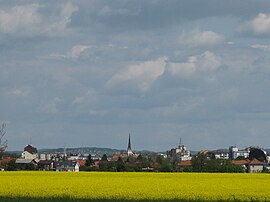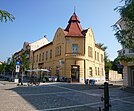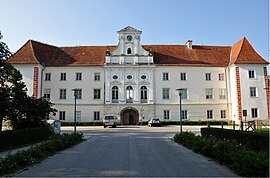Murska Sobota (pronounced [ˈmúːɾska ˈsóːbɔta] ,[1] Slovenian abbreviation: MS [məˈsə̀];[1] German: Olsnitz;[2] Hungarian: Muraszombat[2]) is a town in northeastern Slovenia. It is the centre of the Municipality of Murska Sobota near the Mura River in the region of Prekmurje and is the regional capital.
Murska Sobota | |
|---|---|
Town | |
From top, left to right: Murska Sobota's skyline, Evangelical Church complex, Tourist Information Center, Zvezda Hotel, Murska Sobota Cathedral, Murska Sobota Castle | |
| Coordinates: 46°40′N 16°10′E / 46.667°N 16.167°E | |
| Country | |
| Traditional region | Prekmurje |
| Statistical region | Mura |
| Municipality | Murska Sobota |
| First mention | 1297 (as Belmura) |
| Town rights | around 1479 |
| Government | |
| • Mayor | Aleksander Jevšek (SD) |
| Area | |
• Total | 14.5 km2 (5.6 sq mi) |
| Elevation | 190 m (620 ft) |
| Population (2020) | |
• Total | 11,107 |
| • Density | 770/km2 (2,000/sq mi) |
| Time zone | UTC+01 (CET) |
| • Summer (DST) | UTC+02 (CEST) |
| Post code | 9000 |
| Area Code | 02 |
| Vehicle registration | MS |
| Website | www |
Name
editOfficially, the town is known as Murska Sobota, although informally it is usually simply referred to as Sobota by its inhabitants and Murska by people from other parts of Slovenia.[citation needed] The settlement was first attested in written documents in 1297 as Belmura (and as Murazombatha in 1348 and Murazumbota in 1366).[3] The traditional German name of the town is Olsnitz, which is derived from the old Slovene name Olšnica. The modern Slovene name is a translation of the Hungarian name Muraszombat, which was the official name of the town until 1919. In Hungarian, szombat means 'Saturday', referring to the town's practice of holding fairs every week on that day. Murska Sobota was a district (Hungarian: járás) town of Vas County in the Kingdom of Hungary until 1918. Along with most of Prekmurje, it was annexed by Hungary during World War II, from 1941 to 1944. Between 1944 and 1945 it was under Nazi German occupation, and it was captured by Soviet troops in May 1945. It was also part of the Balatin Sanjak under Ottoman Turkey, which belonged at first to the Budin Eyalet, later the Kanije Eyaleti, before the Treaty of Karlowitz.
History
editMurska Sobota used to be Yugoslavia's northernmost town, and throughout history it has shifted across borders between Slovenia, Yugoslavia, and Hungary. Hungarians still represent a 3,000-person minority. In 1919, the Republic of Prekmurje was declared here and the town was the capital of the new state. In 1991, during the Ten-Day War between Slovenia and the Yugoslav Federal Army, Murska Sobota was bombed from the air, with no casualties or visible damage. Today, it is a quiet town with an economy based on regional administration, light industry, commerce, and spa tourism. In April 2006, the town became the see of the newly created Roman Catholic Diocese of Murska Sobota, which is a suffragan to the archdiocese of Maribor.
Jewish community of Murska Sobota
editThe once significant Jewish community of Murska Sobota was eliminated by Nazi Germany. Before World War II, a synagogue built by Lipót Baumhorn stood in Murska Sobota. It was consecrated on 31 August 1908 and demolished in 1954 by the local communist authorities after they purchased the building from a decimated Jewish community.[4] The last rabbi in Murska Sobota was Lazar Roth.[5] He was murdered at Auschwitz.
On 26 April 1944, all of the Jews were ordered to gather in the Murska Sobota synagogue, with hand luggage only. There, they were locked up overnight without food or water, and the next morning all the Jews of Murska Sobota were transferred to Čakovec and then to Nagykanizsa, the main concentration camp before their final destination of Auschwitz.[6]
On 29 January 2010, the first Holocaust memorial in Slovenia was unveiled at the Murska Sobota railway station. It is dedicated to the exile of Jews from the Prekmurje region.[7][8]
Climate
editAnnual rainfall in Murska Sobota is among the lowest in Slovenia. Characterized by the instability of rainfall, severe droughts are frequent. It has a warm-summer humid continental climate (Dfb) that is uncommon in Slovenia except at higher elevations,
| Climate data for Murska Sobota (1991–2020 normals, extremes 1950–2020) | |||||||||||||
|---|---|---|---|---|---|---|---|---|---|---|---|---|---|
| Month | Jan | Feb | Mar | Apr | May | Jun | Jul | Aug | Sep | Oct | Nov | Dec | Year |
| Record high °C (°F) | 18.4 (65.1) |
22.2 (72.0) |
25.2 (77.4) |
29.7 (85.5) |
33.1 (91.6) |
35.4 (95.7) |
39.0 (102.2) |
39.7 (103.5) |
33.1 (91.6) |
28.1 (82.6) |
24.0 (75.2) |
20.1 (68.2) |
39.7 (103.5) |
| Mean daily maximum °C (°F) | 3.7 (38.7) |
6.9 (44.4) |
11.9 (53.4) |
17.3 (63.1) |
21.6 (70.9) |
25.5 (77.9) |
27.4 (81.3) |
27.2 (81.0) |
21.8 (71.2) |
16.2 (61.2) |
9.6 (49.3) |
4.1 (39.4) |
16.1 (61.0) |
| Daily mean °C (°F) | −0.1 (31.8) |
1.7 (35.1) |
6.1 (43.0) |
11.1 (52.0) |
15.6 (60.1) |
19.3 (66.7) |
20.9 (69.6) |
20.3 (68.5) |
15.3 (59.5) |
10.4 (50.7) |
5.6 (42.1) |
0.6 (33.1) |
10.6 (51.1) |
| Mean daily minimum °C (°F) | −3.7 (25.3) |
−2.9 (26.8) |
0.9 (33.6) |
5.1 (41.2) |
9.7 (49.5) |
13.4 (56.1) |
14.9 (58.8) |
14.6 (58.3) |
10.4 (50.7) |
6.0 (42.8) |
2.2 (36.0) |
−2.6 (27.3) |
5.7 (42.3) |
| Record low °C (°F) | −30.4 (−22.7) |
−28.2 (−18.8) |
−23.7 (−10.7) |
−7.1 (19.2) |
−4.3 (24.3) |
0.5 (32.9) |
3.4 (38.1) |
2.7 (36.9) |
−2.9 (26.8) |
−8.7 (16.3) |
−16.8 (1.8) |
−26.8 (−16.2) |
−30.4 (−22.7) |
| Average precipitation mm (inches) | 28 (1.1) |
39 (1.5) |
42 (1.7) |
50 (2.0) |
84 (3.3) |
95 (3.7) |
96 (3.8) |
94 (3.7) |
100 (3.9) |
70 (2.8) |
66 (2.6) |
47 (1.9) |
812 (32.0) |
| Average extreme snow depth cm (inches) | 4 (1.6) |
5 (2.0) |
1 (0.4) |
0 (0) |
0 (0) |
0 (0) |
0 (0) |
0 (0) |
0 (0) |
0 (0) |
1 (0.4) |
3 (1.2) |
1.1 (0.4) |
| Average precipitation days (≥ 0.1 mm) | 9 | 8 | 9 | 11 | 13 | 13 | 12 | 11 | 11 | 10 | 12 | 10 | 130 |
| Average snowy days (≥ 0 cm) | 13 | 11 | 4 | 0 | 0 | 0 | 0 | 0 | 0 | 0 | 2 | 9 | 39 |
| Average relative humidity (%) (at 14:00) | 75 | 62 | 56 | 51 | 51 | 53 | 50 | 51 | 56 | 63 | 73 | 80 | 60 |
| Mean monthly sunshine hours | 72.5 | 108.5 | 153.8 | 197.7 | 244.6 | 257.5 | 276.1 | 262.8 | 182.2 | 133.7 | 71.7 | 56.1 | 2,017.2 |
| Source 1: Slovenian Environment Agency (humidity and snow 1981–2010)[9][10] | |||||||||||||
| Source 2: NOAA (sun 1991–2020)[11] | |||||||||||||
International relations
editTwin towns – Sister cities
editMurska Sobota is twinned with:
- Firminy, France
- Ingolstadt, Germany
- Bethlehem, Pennsylvania, United States
- Paraćin, Serbia
- Körmend, Hungary
- Podstrana, Croatia
- Turnov, Czech Republic
Notable people
editNotable people that were born or lived in Murska Sobota include the following:
- Filip Draković (born 1991), footballer
- Jernej Šavel (born 1976), musician
- Luana Zajmi (born 29 January 2002) is a Slovenian professional footballer who plays as a midfielder for Split
See also
editReferences
edit- ^ a b "Slovenski pravopis 2001: Murska Sobota".
- ^ a b Radkersburg und Luttenberg (map, 1:75,000). 1894. Vienna: K.u.k. Militärgeographisches Institut.
- ^ Snoj, Marko (2009). Etimološki slovar slovenskih zemljepisnih imen. Ljubljana: Modrijan. p. 276.
- ^ Benko, Andreja (2018). "Kljubovalna judovska sinagoga v Murski Soboti / Die beständige Synagoge in Murska Sobota". VII: Das Magazin der Sloweninnen und Slowenen in der Steiermark: 56–69.
- ^ History of the Jews in Murska Sobota
- ^ Jews of Murska Sobota
- ^ "Memorial to Exiled Jews Unveiled in Murska Sobota". STA. 29 January 2010.
- ^ "A memorial dedicated to the exile of Jews from the NE region of Prekmurje is unveiled at the Murska Sobota train station". STA. 29 January 2010. Archived from the original on 21 July 2011.
- ^ "Rakičan (pri Murski Soboti) Podnebne statistike 1950-2020" (in Slovenian). Slovenian Environmental Agency. Retrieved 4 September 2023.
- ^ "Murska Sobota Climate Normals 1981-2010" (PDF). Slovenian Environmental Agency. Retrieved 4 September 2023.
- ^ "Murska Sobota Climate Normals 1991–2020". World Meteorological Organization Climatological Standard Normals (1991–2020). National Oceanic and Atmospheric Administration. Retrieved 4 September 2023.
External links
edit- Media related to Murska Sobota at Wikimedia Commons
- Murska Sobota on Geopedia
- Aeroklub Murska Sobota







